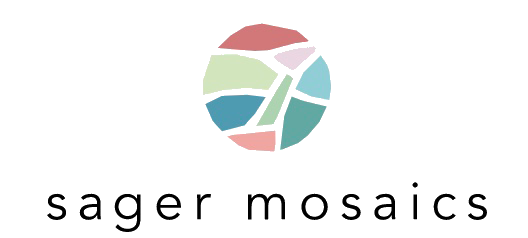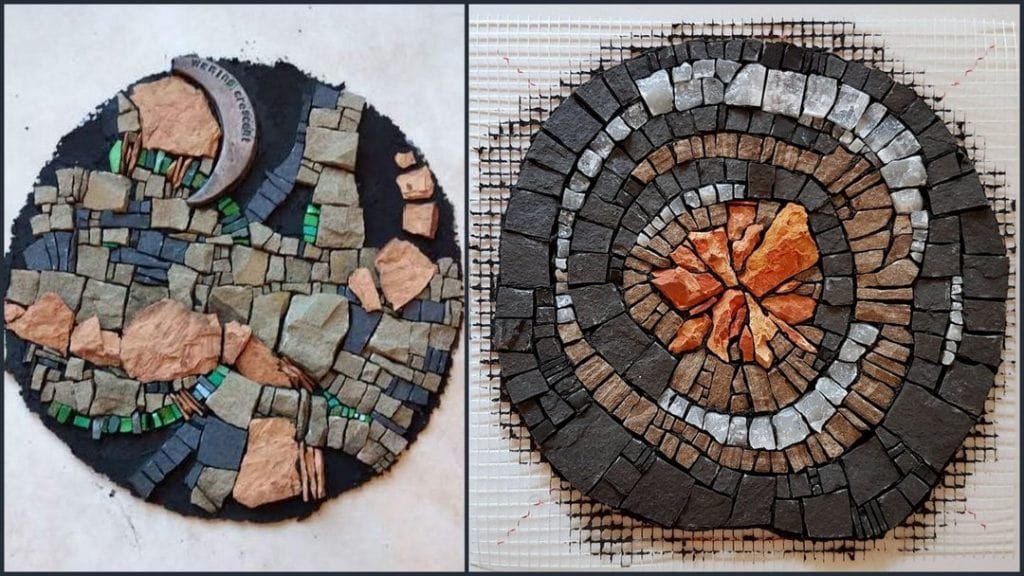A storytelling stone
Makin somethin out of nothin…that’s a line I grew up hearing. The women in my family would use it with a quiet pride after cooking up an impressive meal from what seemed like an empty refrigerator. For years I felt a bit disgraced that I had not mastered the skill. Until all of the sudden, I had. Just not with food. I do it with rocks. Or plates. Or any other raw material that I deem mosaic-worthy. In fact, I’ve built my reputation on it. I love teaching students the miracle of skipping the middle man by foraging for their own material and using the hammer and hardie to turn one man’s junk into another woman’s tesserae.
Now that I am leading all walks of students and appreciators through The Ruins Project, I am finding myself wanting to introduce a material that is quintessential junk to most anyone. Red Dog. Ever heard of it? If you aren’t from deep or slope mine coal country, then you probably have not. I skinned my knees on it racing from creek bed to creek bed as a wild, barefoot child. This irregular, reddish stone was so prevalent that our driveways and back roads were built with it. Red dog was everywhere.
Common, humble, and good for nothing but fill. As I sit here writing, I am trying to unearth memories of how I felt about it back then. I remember appreciating its redness; from afar as it snaked a path through a green field; and up close, with its chaos of ochre, brick, oxblood, terra cotta, copper, and wine.
I remember appreciating and enjoying it. But I never once wondered what exactly it was. It took me becoming an artist to learn about all kinds of practical facts. Like the specific order of layers of stratigraphy in Fayette County, Pennsylvania. Or the meaning of my dear Youghiogheny River, Algonquin for river that flows in a contrary direction.
I now know that red dog (I use the colloquial term because I’ve never heard it called anything else) is a by-product of 19th and 20th century coal extraction. To put it simply, it’s cooked slate. Coal seams often lay nestled tight against slate walls in the geology of a mine. One of the heartbreaking realities of a day in the life of a miner was that they got paid per ton of coal they got onto a railcar. They had to get the slate out too, but they didn’t get paid for it. I can imagine the cursing and animosity a man would have for that particular hard material.
You can still see the remnants of slate dumps, sometimes called gob piles, along the river here. These piles, when mixed with coal, would combust and catch on fire. The reddish colors come from the burning. A little piece of “hell with the lid off” as it was sometimes described.
Cindy Swanson @ The Ruins Project
Maria Jose Iribarne @ The Ruins Project
Why would all these bits of history mean anything to a contemporary artist? Because I care about the nature of any given hunk of rock. I build relationships with raw material. Getting to the inside of these building blocks, both metaphorically and physically, matters to me.
Rachel Sager, Julie Sperling, Helen Miles @ The Ruins Project
And maybe more to the point, red dog, as it turns out, is a highly expressive stone for the mosaicist. But it’s not well-behaved. Its irregular angles and fault lines do not follow the rules of hammer and hardie cutting. You won’t get any cube-like shapes. What you will get is serendipity, in both color and form. I give credit to Lynn Donihe of Virginia for being the first Ruins Project student to embrace, exploit, and transform red dog into Art. Her red dog flowers continue to be a highlight of the entrance wall with their sensitive faceting and whimsical nature.
Lynn Donihe @ The Ruins Project
Who would ever think to equate the word whimsical into the leavings of a coal by-product? That’s what every artist searches for…that element of surprise that can be elevated through technique.
Following Lynn’s lead, many other Ruins Project artists are embracing this strange material and breathing creative life into it.
Rona Pietzrak @ The Ruins Project
Watching the outside world learn to turn this nothing into something rare and even exceptional is one of my great pleasures. I am waiting for someone to come and decide that it’s a good idea to build a red dog out of red dog.
As I continue down this path of letting The Ruins talk to me, a mission statement is finally emerging. It’s not complete, but I’m not sure it needs to be. Like The Ruins themselves, everything they touch asks to be in a beautiful state of possibility. Using the red dog as a colorful messenger, The Ruins is telling me that there is a bond being built between the coal miner of yesterday and the artist of today. It speaks of bridging a wide gap between Labor and Art. It moves with ease through centuries. Turns out, this humble, forgotten red material has its own story to tell. And its not content to fade into the quiet goodnight.
Rachel Sager (left) and Julie Sperling (right) contributions to the Pulaski Polka Dot Project
Sign up for the newsletter
You will receive one or two high quality blogs a month about anything from the state of contemporary mosaic, the power of dreams, the art of foraging to the latest updates on The Ruins.








